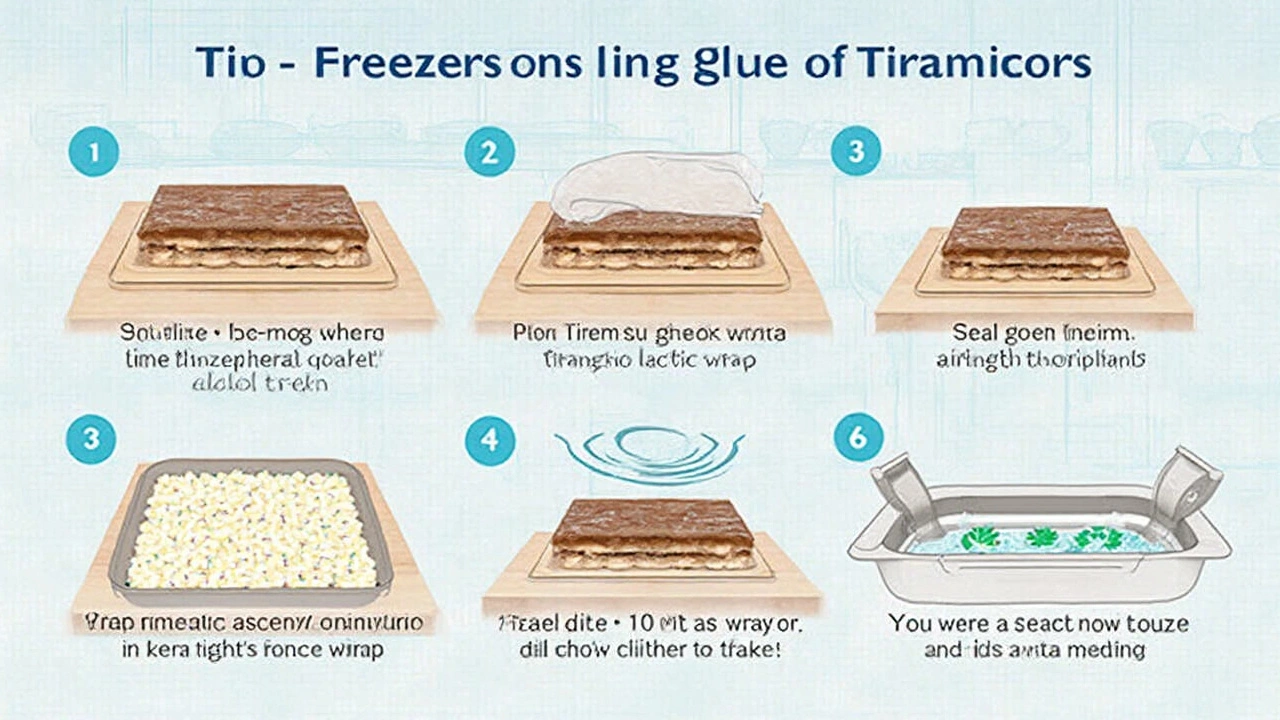
So you ended up with too much tiramisu—maybe you got carried away at the bakery, or your friend brought an extra tray to dinner. Can you pop it in the freezer and enjoy it later? Short answer: yes, totally doable! But not every method works the same, and how you freeze tiramisu can change everything about its taste and that famous creamy texture.
No one wants tiramisu with soggy ladyfingers or ice-crystal-filled mascarpone. Freezing isn’t just tossing it in the cold—there’s a smarter way to keep tiramisu tasting fresh, whether it’s homemade or store-bought. If you do it right, you’ll always have a crowd-pleaser on hand with minimal effort. Let’s break down what you need to know to keep your tiramisu (and your freezer) happy.
- What Happens When You Freeze Tiramisu?
- Step-By-Step Guide: Freezing Ready-Made Tiramisu
- Thawing Without Ruining Texture and Flavor
- Common Mistakes and Handy Tips
What Happens When You Freeze Tiramisu?
Freezing tiramisu sounds easy, but there’s more going on than you might think. This dessert is all about its layers—airy mascarpone, soaked ladyfingers, and that dusting of cocoa powder. When you pop it in the freezer, each part reacts a bit differently.
The big thing to watch out for is texture. The creamy filling holds up pretty well, but the ladyfingers can get a little mushy or even icy if not handled right. The longer tiramisu hangs out in the freezer, the more likely it is for those textures to shift. If water crystals form, you might bite into a mushy or even gritty spoonful instead of the dreamy smooth stuff you’re expecting.
Most store-bought tiramisu uses stabilizers to help it survive freezing, but homemade versions tend to get weepy or separate if left in the freezer too long. That’s why the quality of ready-made dessert can be different after thawing—it’s not just about the cold, but how thawing works after the freeze, too.
Flavor matters too. Freezing can dull the strong espresso notes or even flatten the taste altogether, especially if your tiramisu isn’t sealed well. Nobody wants freezer taste mixing with their dessert.
- Texture can change: Creaminess might hold, but expect soggier ladyfingers if it sits too long.
- Flavor may fade: Coffee and rum flavors can get lost if stored too long or if exposed to air.
- Stabilizers help: Store-bought tiramisu often holds up better than homemade versions.
Worried about spoilage? Here’s some useful info:
| Fresh Tiramisu (In Fridge) | Frozen Tiramisu (In Freezer) |
|---|---|
| 3-4 days max | Up to 3 months |
The bottom line? You can freeze tiramisu, but you’ll probably notice some changes. If taste and texture are everything to you, don’t freeze for too long and never leave it uncovered. A tight wrap keeps out unwanted smells and protects your dessert from ice crystals.
Step-By-Step Guide: Freezing Ready-Made Tiramisu
Freezing ready-made tiramisu isn’t rocket science, but there are a few tricks to keep it from turning into a soggy mess. If you get it right, you’ll have a dessert that tastes almost as good as day one, without weird textures or freezer burn issues. Here’s exactly how to do it:
- Choose Your Container: If your tiramisu is in a flimsy box or tray, transfer it to an airtight, freezer-safe container. Glass or thick plastic works great. If you want to freeze single portions, slice them up now and put each in its own little container.
- Wrap It Up: To keep ice crystals and strange freezer flavors out, wrap the tiramisu tightly in plastic wrap. Then add a layer of foil for an extra seal. It might feel over the top, but you’ll thank yourself later.
- Label Everything: Write the freezing date right on the package. Tiramisu can last up to 3 months in the freezer, but after that, the texture starts to go downhill. You don’t want to guess how long it’s been in there.
- Quick Freeze: Put the container in the coldest part of your freezer. This helps stop big ice crystals from forming, which can mess up the creamy layers.
When freezing store-bought tiramisu, check the ingredients label. If there are any odd add-ins or stabilizers, note that texture can be slightly different after freezing. Classic tiramisu with mascarpone freezes better than versions heavy on whipped cream or egg whites.
Here’s a handy cheat sheet for freezing most desserts and where tiramisu fits in:
| Dessert | Best Freezing Time (Months) | Risk of Texture Change |
|---|---|---|
| Tiramisu | 3 | Low if wrapped properly |
| Cake with Buttercream | 4 | Very Low |
| Cream Puffs | 2 | Medium |
| Fruit Pie | 6 | Low |
With freezing desserts like tiramisu, a little prep now means no disappointment later. And if you’re like me and Jonas, you’ll be grateful for that backup treat when cravings hit.

Thawing Without Ruining Texture and Flavor
No one likes biting into a soggy or icy slice of tiramisu. If you want your frozen tiramisu to taste as good as fresh, the way you thaw it makes all the difference. Don’t just leave it on the counter and hope for the best—there’s an easy method that will keep the ladyfingers from turning to mush and the mascarpone cream smooth instead of watery.
The gold standard? Thaw your ready-made tiramisu in the fridge. It needs time—at least six hours for smaller portions and overnight for a whole tray. This slow thaw keeps the creamy layers intact and avoids puddles on your plate. If you’re short on time, you can slice individual pieces while still frozen and stick them in the fridge to speed things up.
- Remove the protective wrapping while it’s still frozen to avoid condensation dripping into your dessert.
- Place on a plate and cover loosely with foil or plastic wrap—this stops it from picking up weird fridge odors.
- Avoid microwaves or room temperature thawing. Both can make the cream separate and the sponge part go limp.
If you’re wondering about flavor, don’t stress too much. Tests show properly frozen and thawed tiramisu dessert keeps about 90% of its original taste and texture. Check this comparison:
| Thawing Method | Texture | Flavor |
|---|---|---|
| Fridge (6-12 hours) | Soft, creamy, keeps layers intact | Rich, almost no flavor loss |
| Room Temp (2 hours) | Soggy, some separation | Noticeable loss |
| Microwave (defrost mode) | Melty or weirdly firm, possible scrambling | Altered, often metallic |
If you're reheating for a party, thaw the night before, then leave just 15–20 minutes at room temperature before serving. That’s enough to take the chill off but not so long that it melts down. Tiramisu is all about texture, so this little bit of patience totally pays off.
Common Mistakes and Handy Tips
If you want your frozen tiramisu to taste just as good as the day you bought or made it, avoid these common slip-ups. It’s all about treating your dessert with the respect it deserves. Here’s what people usually get wrong with freezing tiramisu, and some tricks you’ll wish you knew earlier.
- Not wrapping it tight enough: Air exposure is the villain here. Tiramisu can easily pick up weird freezer smells (hello, leftover pizza) and get freezer burn. Always use plastic wrap and then foil, or throw it in an airtight container designed for dessert storage. Bonus tip—label it with a date.
- Freezing in a big chunk: It’s tempting to just freeze the whole tray. But if you only want a slice later, it’s a pain to thaw a giant block. Slice and separate pieces with baking paper so you can just grab what you need.
- Freezer overstay: Even though freezing desserts is convenient, leave them in the freezer for months and the flavor drops off. For tiramisu, two to three months is the sweet spot. After that, you risk soggy ladyfingers and bland mascarpone.
- Skipping the crumb coat: For homemade tiramisu, some chefs swear by a thin layer of cocoa powder on top before freezing, which helps lock in moisture and flavor.
- Rushing the thaw: Using the microwave? Big mistake. It ruins the mascarpone’s texture and turns the dessert into a soupy mess. Thaw tiramisu in the fridge overnight for best results.
Curious how long other desserts handle the cold? Here’s a quick comparison:
| Dessert | Freezer Shelf Life | Notes |
|---|---|---|
| Tiramisu | 2–3 months | Wrap tightly, use airtight container |
| Cheesecake | 2–3 months | Freeze without toppings |
| Chocolate Mousse | 1 month | Texture can get grainy |
| Pavlova | Not recommended | Turns soft and sticky |
One last trick I swear by—don’t dust with fresh cocoa powder until after you thaw. It gets weird and soggy in the freezer, so add it fresh right before serving for that classic look and rich taste. Stick to these tips and your ready-made dessert will stay delicious, even after a deep freeze.





